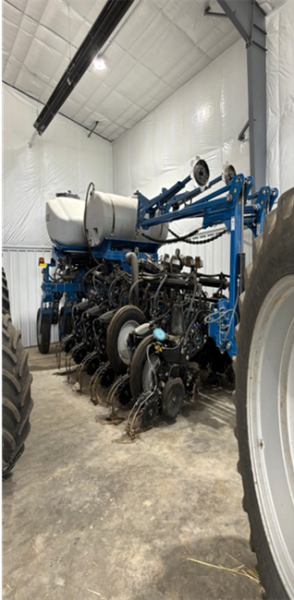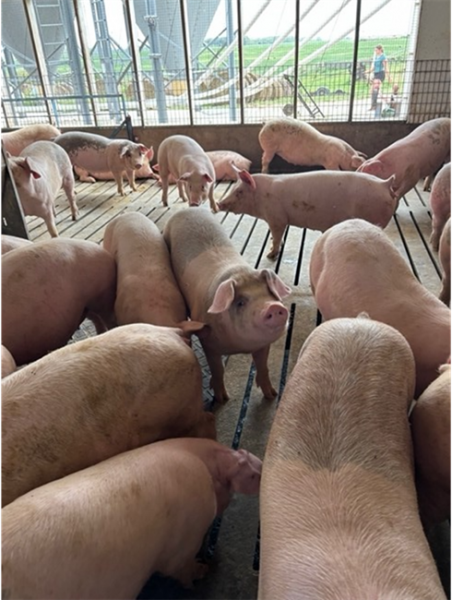Crop Tour Day 12 - Steel Hog Family
By: Sophie Van den Borre, Dylan Van Nes, Jamie VanOoteghem, and Danielle Vogels
On Day 12 of our tour across the Midwest, the Aggies started the day off by sleeping in, with a 7:30am departure with two agricultural stops on the agenda: Kinze and Whetstine’s. The Aggies also got to stop at The World’s Largest Truck Stop on I-80 along the way. The day was filled with family and community-oriented operations that have rebuilt after facing challenges that threatened the survival of their operations.
Kinze manufacturing is the only agricultural equipment company that is completely family owned and operated. Kinze headquarters is in Williamsburg, Iowa. They specialize in producing planters, grain carts, and tillage equipment while custom fabricating their products to meet each farmer's needs. In 1965, Jon Kinzenbaw opened his own small fabrication company at 21 years old with a small loan and $25 in his pocket. His shop focused on repairing and fabricating equipment for farmers in the area. Over time this small fab shop expanded to become Kinze equipment with dealers serving customers globally.
Kinze has always prided themselves on being an innovator in the industry and have been a major competitor in the market due to their strong focus on their three main implements. By listening to farmers' needs, they found innovative ways to find solutions to farmers' problems. Some examples of Kinze creations include the first tool bar, first folding planters, flex planters, pivoting planters for transportation ease, plug and play systems, and so much more!
In a “small” facility with 30-acres under roof coverage and a staff of approximately 650 individuals almost all parts are developed and manufactured in-house for their implements. Kinze builds their products when ordered from farmers through dealers. From April to August, Kinze produces grain carts before switching to manufacturing planters from August to April, with tillage equipment being produced as needed. This facility can assemble a planter in 4.5 days and grain cart in 5 days. This is possible due to their focus on seeking efficient and innovative ways to fit the customer’s needs and wants.

To ensure high quality products for consumers, Kinze manufacturing is highly departmentalized and has a high standard of quality assurance. Quality is checked at multiple stops throughout the production line of all implements. Examples of this are; checking CNC calibrations on every 5th part, random quality inspections in any part of production, and a final audit review area to ensure farmers are receiving an implement with no issues. Another prime example of ensuring quality is their utilization of robotic arm welding and CNC to ensure uniformity between each product.
Kinze focuses on local production and will produce almost all products in house. This being, 85% of parts produced in house with the remaining 15% of parts like plastic, rubber, fiberglass, and cast iron being locally sourced from within a 300-mile radius. With a focus on community and family, on-site training is always provided to expand the skillset of workers. This makes workers more flexible, allowing them to shift between departments within the facility. Additionally, welding apprenticeships, CNC qualifications and engineering co-ops are provided to introduce high school and university students to the industry. Fun fact, many of the co-op students return after graduation to work full time including Ethan and Greg, the test engineers who spoke with us during the visit.
After a brief bus breakdown, we continued to Whetstine Farms to carry on a 56-year Aggie tradition. Whetstine Farms located in Wahington, Iowa, is the oldest stop on the Midwest Crop Tour. For the past 56 years, Aggies have enjoyed learning about the hog operation of the Whetstine family. Clint, alongside his parents Larry and Millie talked to the students about their now, wean to finisher program and their struggles after an EF4 tornado blew through on March 31, 2023.
During the spring of 2023, 2 out of 3 barns were completely flattened from this tornado. They decided not to rebuild their 2,000 head farrowing barn and sold some of their Sow Co-Op shares. Along with 2 of 3 barns being flattened, their shop was also destroyed (not the combine…) but was rebuilt this past February.
Claiming insurance came with its challenges as they did not have as much insurance as they had thought. They were only insured with about 1/3 of what would have been necessary to cover their farm. Farm Rescue and many community volunteers helped the Whetstine’s clean up and re-start farm operations. Farm Rescue helped to plant 30 acres of soybeans, as well as providing a tractor for Clint to run his corn planter. Working with Farm Rescue came with a lot of media attention for Clint and many interviews. Clint learned about Farm Rescue through Wyffels seeds whom he sells seed for.
Whetstine’s farm 1,150 acres of row crops with a 3-year rotation of corn-corn-soybeans. They grow 111d to 118d corn. Almost all their land is heavy clay soil with tile drainage. Their tillage practices are very minimal with limited vertical tillage done before second crop corn.
All their hog manure goes back on their fields allowing them to have very nutrient rich land. Clint has incorporated variable rate technology into their practices for planting and nitrogen applications. Clint owns a Kinze planter with flex to plant efficiently on hills, this technology was invented by Kinze themselves which we learned about this morning.
European corn borer has been a significant issue this year as well as tar spot. Since their winters are mild, these pests are overwintering causing more issues. The majority of their row crops are used to feed their livestock. Hay is also grown on farm. They have their own computerized feed mill where they feed soybean meal, a premix, and corn. However, for the pigs under 80lbs they’re fed a ration bought from a separate feed mill.

Whetstine’s have a wean to finish barn. This was modified after the tornado when their nursery barn was destroyed. This allowed them to increase efficiency and raise around 1,200 head of feeder pigs per month. They receive 9 cycles of pigs per year with each group being raise for 6 and ½ months. The hogs are then marketed through Livestock Producers to 3 different packaging plants at an average weight of 300 lbs. However, when barns are beginning to get crowded, they will ship some pigs as early as 260 lbs. Pigs are received Monday and Thursday of week 4 and 8, with some pigs being raised at an offsite nursery, rented from another producer. This morning, close to 600 pigs were delivered.
Their biggest challenge with biosecurity is PRRS. Porcine respiratory and reproductive systems disease. This disease weakens their immune systems. Washington County Iowa is known for being a very high hog producing area.
Therefore, since PRRS is an airborne disease there is a high risk of infection on the Whetstine family farm.
This year’s Aggies were extremely honoured to be the 56th group of Aggies to tour this operation. Larry, Millie, and Clint answered all our questions and gave a wonderful tour of their farm. It should also be noted that many of the students enjoyed playing with the barn kittens, many showing their future as a “crazy cat ladies”. They were also extremely kind enough to offer us lemonade, water, and some delicious cookies.
A pitstop at the World’s Largest Truck Stop left us all in awe of all the interesting souvenirs available. After 12 days on the bus, many of us wish we had time to use the on-site chiropractor. Now the Aggies are on their way to Princeton, Illinois for a good sleep before our 5:30am departure tomorrow. Sophie, Dylan, Jaime and Dani will have more information tomorrow on our visit to Red Gold Tomatoes. This will be our last farm stop before we travel back to Guelph!

